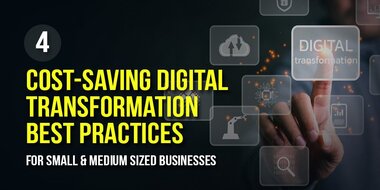Digital transformation for SMBs is essential to future-proof their products and services, boost customer loyalty, and grow revenues. Technology is rapidly evolving, and staying relevant in today's times is paramount to every organization. Even the smallest businesses can reach a global audience, explore opportunities, and tap into new markets with the right digital transformation strategy.
The global digital transformation market is estimated to be valued at USD 127.5 billion by 2026 and grow at a CAGR of 19.1% from 2021 to 26 annually. Modern consumers want seamless interactive experiences via responsible apps, websites, and mobile communication channels.
We've got you covered if you want to make your digital transformation journey smoother and hassle-free.
Why Do Digital Transformation Initiatives Fail?
A Deloitte study shows that over 70% of all digital transformation initiatives fail, and companies take up to 3 years to get them right. Here are a few key reasons why organizations fail in their digital transformation journey:
1. Using the Wrong Technologies
Companies fail to replace legacy systems with the latest technologies. And sometimes, when they choose technologies, they pick the wrong ones. Not every solution is ideal and ensuring that digital transformation solutions align with business requirements is essential. Other aspects of choosing the wrong technology stack are failing to ensure continuous compliance and not establishing security baselines.
2. Not Understanding Your Customers
The best digital transformation initiatives are customer-centric and people-focused. The digital transformation market is highly dynamic, and it is essential to improve consumer experiences. A company can only achieve a successful digital transformation if it understands its customers' needs, expectations, and pain points. Collecting feedback is vital to understanding which product or service features to retain or remove. Negative feedback is equally important as it highlights strengths and weaknesses and assists businesses with narrowing down on them.
Research shows that many companies lack clarity regarding thought leadership and gaining direction. Market volatility, poor customer engagement, and a lack of inspiration force digital transformation programs to falter quickly.
3. Embracing a “Fail Fast” Attitude
According to CEO and co-founder of Phrasee, Parry Malm, companies that adopt a fail-fast mindset don’t give enough room for their current projects to succeed. He says: “The problem is, you accept failure and don’t give a second thought to your following actions since you expect to fail.”
He advises companies to strengthen their commitments to current initiatives, focus on achieving milestones, and improve. Ray Wang, founder of Constellation Research, also expressed similar concerns and voiced: "If you are hoping to achieve a successful digital transformation, look at your current business model and understand how you can monetize. Understanding that the data you collect should align with your long-term investment horizon and ensure you hire the right people on your team. These are the basics."
Sometimes, automation initiatives align with technical and business goals. Digital transformation must strike a delicate balance between technology adoption, culture change, and forming new habits to catapult the organization to success.

5 Digital Transformation Best Practices for SMBs in 2024
Here are five cost-saving digital transformation best practices for small and medium-sized businesses:
1. Create an Online Presence
Consumers prefer to interact with businesses with an excellent online presence. Even stores that operate offline traditionally must create social media handles. Many brands build digital identities by launching their websites. All pages must be correctly optimized to reduce bounce rates and ensure a smooth navigation experience.
Hiring web developers can go a long way toward improving your business prospects. Refining your website strategy can make the right impact and generate more leads and sales.
2. Adopt Cloud Computing
Organizations are modernizing their digital transformation journey by migrating to the cloud. Unlike traditional infrastructure platforms, the cloud offers unlimited storage, flexibility, and scalability. It leads to increased cost-efficiency, and SMBs can use cloud service providers like Microsoft Azure, Google Cloud Platform, and AWS to access enterprise-grade tools and features without investing in additional hardware or equipment. The cloud is at the forefront of technological innovations and can be integrated with supply chains, logistics, sales, accounting, and other domains.
3. Emphasize Cybersecurity
SMBs are attractive targets of hackers and cyber adversaries due to perceived vulnerabilities. To ensure long-term success, it is critical to safeguard customer data and guarantee their privacy. Robust cybersecurity measures, such as multifactor authentication, firewalls, encryption protocols, and regular software updates, can positively impact organizations. Training employees on the best cyber hygiene practices and encouraging them to take personal accountability for sensitive data is also essential.
4. Use Agile Methodologies
Successful digital transformations embrace Agile methodologies because businesses constantly change and innovate. Continually assess your current digital transformation efforts and make adjustments accordingly. Identify KPIs, take controlled risks, experiment, and innovate.
There should be a clear link between your methodology and how you hope to achieve your milestones. Microsoft is an excellent example of one of the world's leading tech firms that used Agile methodologies to transform its company's culture. When Satya Nadella shifted from a desktop-driven revenue base and migrated to cloud computing, the company strengthened its market position, thus making its future brighter.
The four principles of an Agile digital transformation are:
- Developing a vision – Identify the possibilities of incorporating next-gen technologies and realize their limits. The business should be able to monitor and measure progress, make real-time performance adjustments, and improve customer outcomes. Senior management must communicate with team members about the digital vision and its future outlook.
- Build customer engagement – Successful marketers know that products are sold to people through digital channels. Satisfying customer expectations is critical to ensure ongoing business and revenue growth. Customers want personalized experiences, and businesses can analyze data to determine their wants. You can drive customer engagement more by enhancing the front-end experience. Use chatbots to automate digital experiences and leverage intelligent automation and AI algorithms across social media, mobile, web, and cloud channels.
- Use secure digital platforms – An excellent digital platform is the backbone of a successful digital transformation. Many digital transformation companies in the market can assist with this. Depending on their budget, organizations may also design their custom digital transformation platforms for the best results. A secure digital platform should empower the company and provide features such as managed services, virtual consultations, and excellent data storage capabilities. Powerful digital platforms bundle features such as open datasets, application programming interfaces (APIs), seamless integrations with third-party tools, and collaboration services. Leading organizations are gradually implementing digital platforms in phases and bridging connectivity gaps.
- Acquire insights using data-driven visualizations – Progressive digital organizations build a strong foundation by making data-driven decisions. One of the best ways to do that is to collect real-time data from multiple sources and analyze them. Adding the necessary dimensionality and deriving meaningful insights through analysis is crucial. Compelling data visualizations use a mix of plots, infographics, statistical graphs, and evidence. It ensures smooth understanding between executives and stakeholders, reduces workloads, and ultimately, can cut down on application development costs.
5. Follow the Latest Digital Transformation Trends
Organizations are increasingly focusing on developing more connected user experiences. Consumers expect consistency across multiple sales and communication channels, mobile services, and messaging platforms. Omni-channel customer experiences are gaining preference over single-channel customer communication. Personalization of business services is another significant trend to watch out for.
Organizations must embrace 'more innovative personalization' practices, which apply to their products and services, not just content. Digital transformation service providers are implementing a new workplace culture by deploying intelligent Enterprise Resource Planning (ERP) systems. ERP systems improve resource utilization, enhance productivity, and reduce unnecessary spending. It can free up time for employees to focus on more critical tasks, boost profitability, and produce measurable results.
The usage of multi-cloud environments is a popular digital transformation trend. Many enterprises use Cloud-Native Application Protection Platforms (CNAPP) to boost cloud security and containerization to address regulatory concerns with cloud environments. Digital governance can be an internal and external challenge, but these solutions address it. Get multi-cloud managed services to achieve the best results with your digital transformation journey.
Conclusion:
Choose your projects selectively, and don't rush the process regarding your company's digital transformation. Knowledge of digital transformation best practices, systems, and tools will enable your employees to perform their best and speed up daily operations. You can create a custom digital transformation roadmap by hiring a company to work with you.
At Clarion Technologies, we focus on building low-code and customizable digital transformation technology solutions you can implement with your latest projects. You can integrate industry-leading process automation, streamline workflows, and build highly structured business apps with us.
Connect with us to learn more about our offerings and how to get started.








